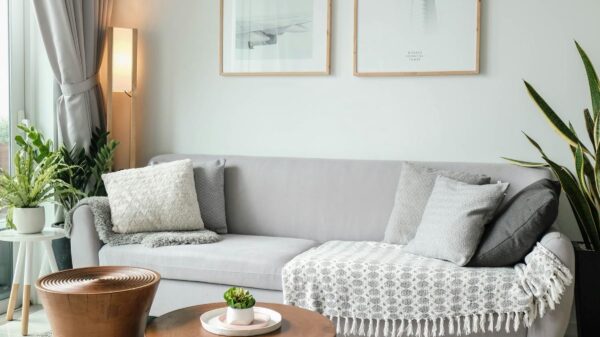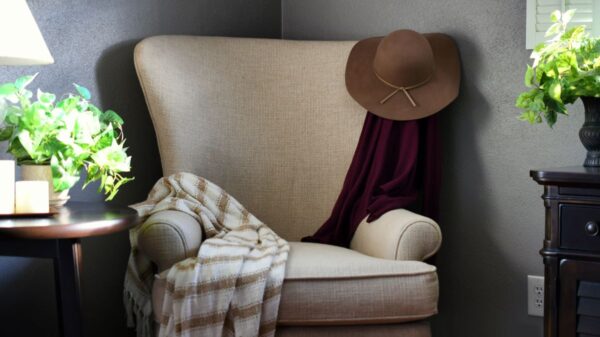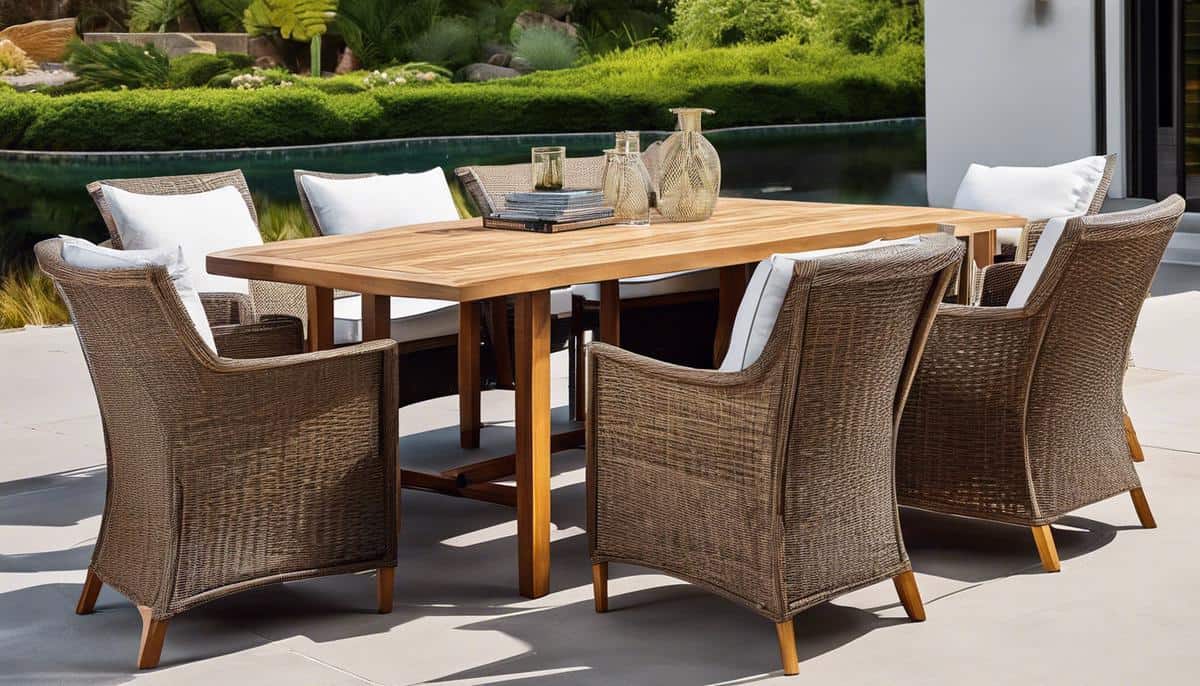Best Chic Patio Furniture Designs & Trends
Welcome to the refreshing world of patio furniture design where comfort meets sustainability under the open sky. As outdoor spaces become extensions of our homes, selecting the right patio furniture has evolved beyond mere aesthetics to encompass materials that respect our planet, ergonomic designs for utmost comfort, and styles that reflect our flair. Whether you have a sprawling backyard or a cozy balcony, understanding the nuances of material choice, comfort considerations, and space planning can transform your outdoor area into an inviting haven. Immerse yourself in this insightful guide to chic patio furniture designs & trends. Discover the diverse options and make informed decisions that will elevate your outdoor living experience.
Materials and Sustainability
When on the hunt for outdoor lounging or dining areas, two words should be at the forefront of any savvy shopper’s mind: durability and sustainability. Patio furniture battles the elements daily, from rain to sun to the occasional clumsy barbecue guest. It needs to be tough, but it also needs to tread lightly on our planet. So, what materials check these essential boxes?
Let’s start with a hearty round of applause for Teak. This hardwood has a well-earned reputation for being incredibly durable and can easily live longer than a pet tortoise if taken care of properly. It’s naturally rich in oils that fend off decay and pests, with a tough-as-nails aspect that laughs in the face of inclement weather. The source of your teak matters, though; always look for the blessing of the Forest Stewardship Council (FSC) stamp, ensuring your lounge-worthy investment supports responsible forestry practices.
Aluminum is another contender, and it’s not the flimsy foil type. Cast or wrought aluminum used in outdoor furniture is as strong as it is lightweight, and it won’t surrender to rust or fading, thanks to its trusty powder-coated finish. Plus, aluminum can be recycled over and over without losing its qualities, making it a champion of sustainability.
Wicker has a timeless look, but traditional materials can require lots of upkeep. Enter all-weather wicker, also known as resin wicker. This synthetically engineered twin mimics natural wicker’s appearance but with a superpower: weather resistance. You get the best of both worlds – durability and less strain on natural resources. However, it’s crucial to ensure that your resin wicker furniture does not contain harmful chemicals and that it can be recycled to prevent it from ending up in a landfill.
Don’t forget about stainless steel. It’s like the superhero of patio furniture materials. Not only does it bring a sleek, modern look to your backyard, but its corrosion resistance is off the charts. Opt for 304-grade stainless steel or even better, marine-grade for waterfront properties. It’s on the heavier side, so consider this when thinking about rearranging your layout for those impromptu summer parties.
Last but not least, let’s talk about recycled plastic. Yes, plastic typically gets a bad rap, but when it’s recycled, it gets a new life and decreases the demand for new plastic production. High-density polyethylene (HDPE) is a recycled plastic material often used in outdoor furniture, it’s incredibly durable, resistant to moisture, and available in a variety of colors. Best of all, it keeps those milk jugs and detergent bottles out of our oceans and landfills.
When furnishing your patio, both style and substance matter. Consider teak, aluminum, all-weather wicker, stainless steel, and recycled plastic as materials that meet the criteria for durability and sustainability. With the right care, any of these options can offer years of outdoor enjoyment without leaving a heavy footprint on Mother Nature.

Comfort and Ergonomic Elements Of Chic Patio Furniture Designs & Trends
Ergonomics plays a big role in how comfortable patio furniture is, and when we talk about comfort, it’s not just about the softness of a cushion. Ergonomics is the study of how things are designed in relation to how we use them. Good design can make a chair or a sofa feel like it was made just for you!
When designers create patio furniture with ergonomics in mind, they think about the shapes and sizes of different people. They consider things like how tall people are, how we like to sit, and where our arms naturally rest. This makes sure that everyone can sit comfortably, without feeling like they’re perched on a stool or squished into a tiny seat.
A chair with good ergonomics will support the natural curve of your spine. That means less back pain after sitting for a long time. The height of the seat is important too. If it’s too high, the legs dangle and can feel numb after a while. If it’s too low, getting up can be a struggle. The goal is to find the sweet spot so feet can rest flat on the ground, giving you a stable and secure sit-down.
Now, armrests matter as well. They should be at the right height to relax your shoulders, not so high that you feel like you’re shrugging, and not so low that you’re slouching. With outdoor lounge chairs, the ability to recline can be a game-changer, offering positions that are just perfect for relaxing.
The material of the furniture also impacts comfort. Fabrics for cushions should be breathable, so you don’t get too hot and sticky on warmer days. Cushions should dry fast, too, because no one likes sitting on a soggy chair. They should be firm enough to support you, but soft enough to feel cozy. It’s all about balance.
Last, the overall design of the furniture should fit the space. A big, bulky chair might be super comfy, but if it makes your patio feel cramped, it won’t be very relaxing. Ergonomics means thinking about how you move around your furniture, how it fits in your space, and how easy it is to use.
So, when looking at patio furniture, remember ergonomics is key to comfort. Just like a favorite pair of shoes, the right patio furniture should feel good as soon as you sit down, and still feel right after hours of lounging. Remember to test out furniture whenever possible, because comfort is something you have to feel for yourself.
Style and Aesthetics
Finding harmony between your outdoor oasis and your home’s aesthetic might seem tricky, but with the right approach, you can easily align your patio furniture with the style and vibe of your living space. Whether you’re nestled in a craftsman bungalow, perched in a sleek modern loft, or cozied up in a quaint cottage, the goal is to create a fluid transition from indoors to outdoors that reflects your unique sense of style.
Start with Color Coordination
When it’s time to pick out patio pieces, keep the color palette of your home in mind. For a seamless look, select outdoor cushions and accents that complement the interior paint hues or echo the tones in your flooring or roofing. If your house showcases bold colors, carry that vibrant energy outside with similarly spirited shades. If neutral tones dominate your abode, extend that serenity to your outdoor furnishings with taupes, grays, and creams.
Consider the Architectural Style
The architecture of your home should guide the design of your patio setup. Sleek, minimalist furnishings align well with contemporary homes, while wrought iron or intricately designed pieces resonate with the ornate details of Victorian architecture. For those in rustic retreats or country homes, natural wood or chunky, rugged designs can underscore the earthy feel of your dwelling.
Play with Patterns and Textures
Mixing patterns and textures can add depth and interest to your outdoor space. Introduce outdoor rugs, throw pillows, and cushions to mirror the interior decor of your home. If you have floral curtains inside, consider patio cushions with a botanical pattern. If your living room features a leather couch, try adding wicker furniture with textured weaves outside to maintain that tactile experience.
Focus on Functional Layouts
Aside from aesthetics, consider how you want to use your outdoor space. If you enjoy hosting dinner parties, ensure your patio table is large enough to accommodate guests, mirroring the welcoming atmosphere of your indoor dining area. Should your living room be the heart of relaxation, transfer that feel outside with plush lounge chairs or a cozy hammock?
Lighting Is Key
The lighting you choose should both illuminate your patio and elevate its connection to your home. Solar-powered lights can give a soft, eco-friendly glow, while string lights can evoke the warm, inviting ambiance of your favorite room inside. For contemporary homes, opt for clean-lined lanterns or LED fixtures. In more traditional spaces, lanterns or sconces with intricate designs can mirror the historical nuances of your interior.
Finish with Personal Touches
Personal touches are the secret ingredients that will bond your indoor and outdoor spaces. Display outdoor-safe art that matches the character of pieces indoors, or use similar planters for continuity in your botanical decor. Showcasing personal style through these details is what transforms your patio into an extension of your home, blurring the lines between the two spaces.
Harmonizing your patio furniture with your home doesn’t have to be an arduous task. By keeping color, architecture, patterns, textures, function, lighting, and personalized flair in mind, you’ll craft an outdoor space that’s more than just a backyard—it’s an extension of your living environment. With these tips, an inviting patio that pays homage to your home’s aesthetic is well within reach.

Space Planning and Layout For Chic Patio Furniture Designs & Trends
Creating a Welcoming Outdoor Retreat: Patio Furniture Layout Best Practices
Ah, the great outdoors! Transforming a patio into a delightful retreat starts with not just picking the right materials and design elements but arranging them in a way that makes the space both inviting and functional. Here’s how to get the spacing just right and make your outdoor living space a hit.
First, consider the flow of movement. You’ll want to ensure there’s enough room to walk around comfortably—no squeezing past a chair or shimmying between tables. Generally, aim for about 30 inches of walkway between pieces where possible. This keeps the area open and avoids that cramped feeling.
Next up, think about the purpose of your patio. Is it for dining, lounging, or both? The layout should reflect the primary use. Dining areas benefit from a large table as the central focus, with chairs distributed evenly for easy conversation. Meanwhile, a lounge area might have a cozy sectional or a couple of chaise lounges with side tables for snacks and drinks.
Zoning is a valuable technique in space planning. Break up your space into different ‘zones’ for specific activities. A small reading nook with a comfy chair and side table in one corner, a dining space in another, and a grouping of chairs around a fire pit can offer variety and make larger patios feel more intimate.
Speaking of intimacy, consider the scale of the furniture relative to your space. Bulky, oversized pieces may overwhelm a small patio. Pick furniture that fits comfortably within the area, leaving enough space to breathe.
Remember the rule of ‘less is more.’ Clutter can ruin any outdoor setting. Keep it simple with the number of pieces, and choose multi-functional furniture when possible—think storage ottomans or benches with hidden compartments.
Visual balance is key. Distribute visual weight evenly. This doesn’t mean everything has to be symmetrical but try not to have all the heavy or bulky items on one side of the patio. Balance also relates to the way the furniture complements the natural elements. Ensure that any plants or trees have enough space to flourish without being crowded by furniture.
Lastly, play with angles. Furniture doesn’t have to be aligned strictly parallel or perpendicular to your home. Sometimes, angling loungers or a sofa can create a more engaging and dynamic area. Just make sure it doesn’t interrupt the flow or the functional use of the space.

Conclusion
Ultimately, the best patio layout is one that reflects personality, is comfortable and encourages relaxation and enjoyment of the outdoor space. With these best practices in mind, you’re well on your way to creating a patio where memories are made under the sun and stars. With these ideas for chic patio furniture designs & trends, you will never want to leave your patio!
Embracing the art of outdoor decoration with thoughtful selections in patio furniture not only enriches your personal space but also contributes to a more sustainable environment. As you now carry the knowledge of materials, ergonomics, style, and space planning, imagine the potential of your outdoor sanctuary. Carefully chosen, durable, and stylish patio pieces promise to offer years of enjoyment and tranquility. Remember, the ultimate patio reflects your lifestyle and values, merging seamlessly with the natural world. Let your outdoor space be a testament to thoughtful design and a testament to your commitment to comfort and sustainability.





























